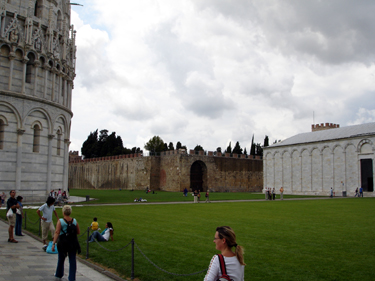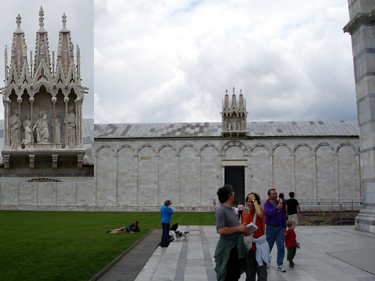Pisa
Pisa is an old city, without anyone knowing exactly how old.
It certainly dates back before the Romans, but its origins
remain somewhat of a mystery Pisa
is located in the province of Tuscany,
on the banks of the Arno River and is near the coast of the Liguian
Sea.
Pisa's Piazza
Pisa's most famous sites are located in the Piazza dei Miracoli or
"Sguare of Miracles."
The
Leaning Tower
If I were to ask who the architect of the Leaning Tower of
Pisa,
I would get a variety of answers. The truth is no one knows,
and it was hardly a one man job. Construction began for the
Tower in 1173 and wasn't completed until 1360. Delays were
due to several factors, but the most major was probably the lean.
When the builder reached the third floor, they stopped
because the tilting became aparent. Many different architects
over the years tried to counteract the pull of gravity and a
sandy foundation. The tower actually has a curve built in it
to try to counteract the sinking. When we went, there were
cables reinforcing the tower. Tower is a working bell tower
and was built for the Duomo or Catherdral right next door.
The
Duomo di Pisa
This Cathedral is the heart of the square. It was
the first
built. Construction began 1064. It contains artwork by famous
artists Giambolna, Dela Robbia, Riminaldi, Bonnano and Giovanni Pisano,
and
others. The Duomo suffered from a fire in 1595, after which it was
largely redecorated.
The
Baptistry
The Baptistry of St John has a large round
Romanesque dome, which provides excellent acoustics. It is
the
largest baptistry in Italy. Construction began 1153, but was not
completed until 1363 because it encountered similar issues as the
Leaning Tower. It also has a slite tilt of 0.6 degrees.
The
Campo Santo
This cemtery lies at the northern edge of the Piazza. This
walled
area was built to move exsisting graves around the Duomo, making the
cathedral more accessible. It was built around the 13th century.
Bombing during WWII destroyed the ceiling and damaged the artwork which
once adorned the walls. In the picture on the left you can see the
original city wall and main entrance to the square in medieval times.


Museo
delle Sinopie
The surviving murals from Campo Santo are now housed in the
Museo delle Sinopie.